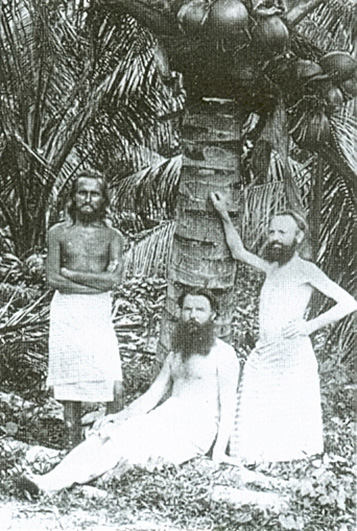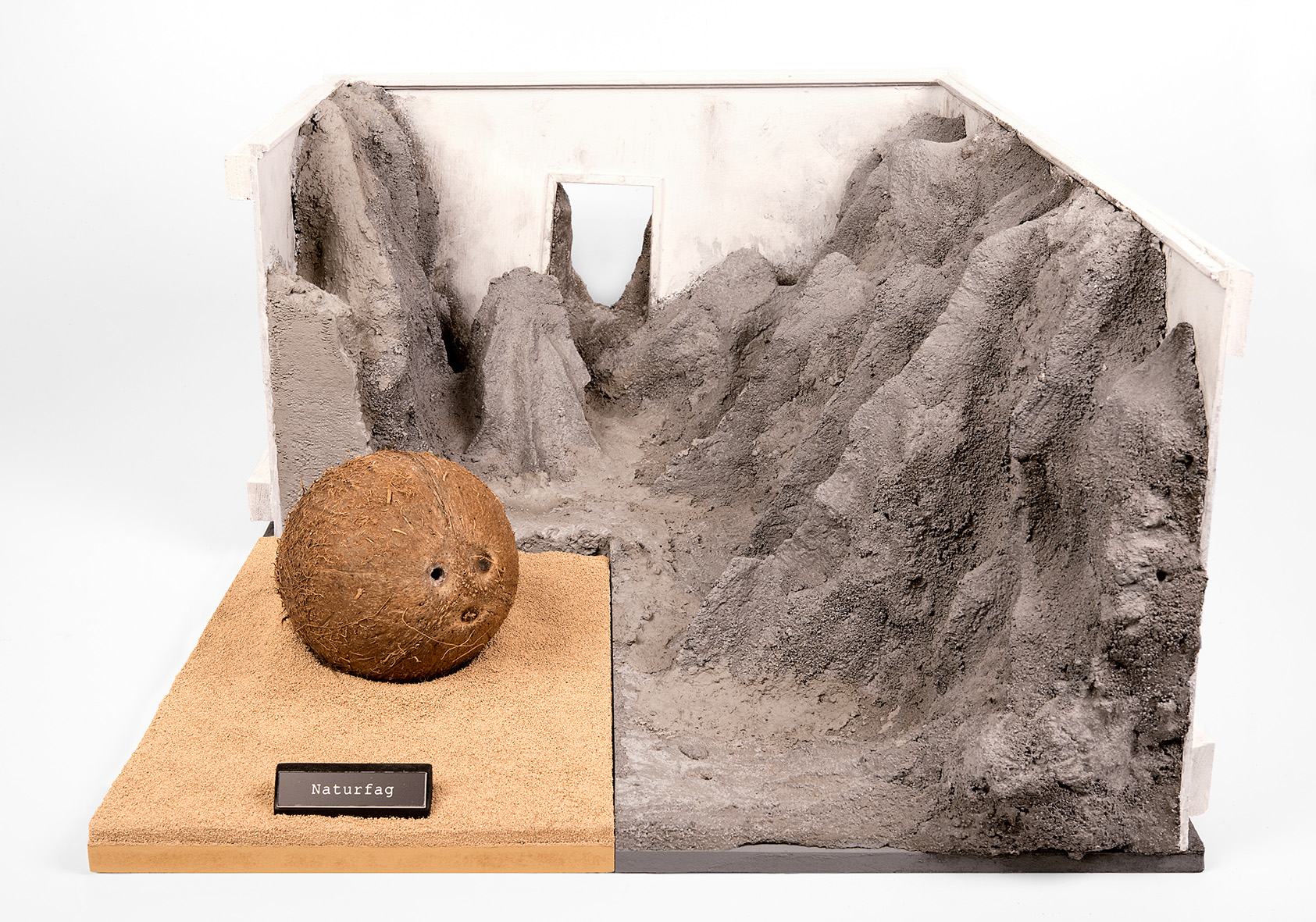Naturfag
The Coconut
In 1746 the world’s largest greenhouse was unveiled in the Botanical Garden in Lisbon. The greenhouse, which contained all known species of the coconut palm tree, was initiated and paid for by the French author, historian and philosopher Voltaire (1694–1778), apparently to satisfy his passion (and appetite) for coconuts. He referred to the coconut both as ”the flesh of enlightenment” and ”the Moon turned inside out”.
It is said that artists and writers didn’t have to travel further than Voltaire’s palm house to portray The New World. However, during the famous Lisbon earthquake of 1755 (described by Voltaire in his novel Candide, and by many regarded as the birth of the modern world), the greenhouse collapsed. In his book Essay on the Manners of Nations (1756) Voltaire describes what he was faced with when entering the ruined greenhouse: ”Thousands of shattered coconuts covered the ground, emitting a divine, dazzling light. It looked as if the Moon itself had fallen from the sky”.
To commemorate the epoch-making earthquake, and also, in what Voltaire described as ”an attempt to lift the Moon back to its proper place”, he initiated the building of a monument: a column made of coconut shells. The column is today to be seen at the Musée Carnavalet in Paris, standing next to the chair that Voltaire wrote and died in.
Returning from his first expedition to central Africa in 1877, the Welsh journalist and explorer Henry Morton Stanley (1841–1904) brought with him, among other things, a column made of coconut shells, appropriated from the Amahagger tribe in Congo. Stanley’s account of his journey, presented in a series of articles in the New York Herald titled Through the Dark Continent, made the Scottish social anthropologist James George Frazer (1854–1941) conduct a more thorough field study of the life and customs of the Amahagger tribe. In his book The Golden Bough (1890) Frazer writes:
In a pagan rite, naked men gathered around a column made of coconuts, looking almost endless as the top disappeared in the crowns of the palm trees surrounding the circular clearing.[…] Then, at the peak of the ecstatic dance, one of the men began to climb up the column, higher and higher, until he vanished out of sight.[…] After sunset the exact same rite was repeated in the flickering light of open fires and flaming torches.[…] I later learned that the rite was held in honour of the Sun and the Moon. As the tribal chief explained: ’We climb to the Moon in the daytime to avoid being blinded, and to the Sun at night-time to avoid being burned’.
On his death bed in 1904 Henry Morton Stanley donated his coconut column, together with the rest of his collection of Congolesian artifacts, to Musée d’Ethnographie du Trocadéro in Paris. Since Congo was a French colony at the time, this was, in Stanley’s eyes, the only correct thing to do, but nevertheless a controversial decision in Great Britain. However, in 1909, Britain succeeded in getting the collection back by trading it with a collection of Native American artifacts given to them by the French explorer La Salle during the French and British colonization of central America in 1683.
From the early 1870s and the following decades, huge amounts of African artifacts was brought to Europe as a result of the constantly expanding African colonies. Some of them ended up in Musée d’Ethnographie du Trocadéro in Paris. For many artists, with Picasso as the most obvious example, a visit to Musée du Trocadéro was a life-changing experience. The Romanian sculptor Constantin Brancusi (1876–1957) described his first visit to the Trocadéro in 1907, with Stanley’s collection making a particularly deep impression on him: ”It was like entering the fourth dimension: the shapes, colours and perspectives were of another planet”.
In 1934, Brancusi’s 30-metre tall monument Endless Column was erected in Targu Jiu, Romania. But both Brancusi and his monument were facing hard times: The Second World War, decades of Communist regime, and a government-initiated attempt to topple the monument in the early fifties. In a letter written shortly before his death in 1957, Brancusi wrote to his friend Marcel Duchamp: “This is the Providence of my Column: to get transformed by lightning in order to unite the sky with the earth, to serve as a bridge between dimensions that ceaselessly expand and contract, to lift the Moon back to its proper place”.
Seven months after Brancusi’s death, the Soviet Union succeeded in placing the first artificial satellite, Sputnik 1 (commonly called New Moon), into Earth-orbit. In the American media, the satellite was immediately nicknamed The Coconut.
Lenker
https://en.wikipedia.org/wiki/August_Engelhardt
http://artsfuse.org/132298/fuse-book-review-imperium-a-shock-packed-pastiche-of-history/
https://en.wikipedia.org/wiki/Imperium_(Kracht_novel)
https://en.wikipedia.org/wiki/William_Blake%27s_illustrations_of_Paradise_Lost
http://www.danshort.com/pl/index.php?p=37
https://en.wikipedia.org/wiki/Heart_of_Darkness
http://www.bookdrum.com/books/heart-of-darkness/9780140186529/bookmarks-51-75.html?bookId=284
http://www.icm.arts.cornell.edu/seth_postcolonial_studies_reading.pdf
http://www.metmuseum.org/toah/hd/aima/hd_aima.htm
http://arttattler.com/archiveafricanartmet.html
https://en.wikipedia.org/wiki/Picasso%27s_African_Period
https://en.wikipedia.org/wiki/Primitivism
https://en.wikipedia.org/wiki/Cubism
http://barbarahepworth.org.uk/sculptures/1936/carving/
http://www.veniceclayartists.com/cubism-ceramic-and-sculpture/
http://resultsvary.blogspot.nl/2010/06/barbara-hepworth.html
http://www.dailyicon.net/2009/01/yves-saint-laurent-brancusi-sculpture-on-auction-at-christies/
http://www.codart.com/exhibitions/details/646/
https://en.wikipedia.org/wiki/Maria_Sibylla_Merian
http://biblioklept.org/2011/01/07/walton-fords-strange-naturalism/
http://blog.sixtyhotels.com/walton-fords-watercolors-paul-kasmin-gallery/
https://www.bowdoin.edu/art-history/student-research/zoe-lescaze-12.shtml
http://www.huffingtonpost.com/kisa-lala/walton-ford_b_1141359.html
<shttp://horrorpedia.com/2014/09/16/king-kong-1933/>
http://flawediamonds.blogspot.no/2015/01/overindulgence-and-ape-king-kong-2005.html
http://kellyenright.com/tag/gorillas/
https://en.wikipedia.org/wiki/Cabinet_of_curiosities
http://magpieandwhiskeyjack.blogspot.no/2011/07/collecting-wunderkammer.html
http://webox-wunderkammer.tumblr.com/ - 15063099125
https://theappendix.net/blog/2012/11/cabinets-of-curiosity:-the-web-as-wunderkammer
http://nevolution.typepad.com/theories/2010/06/mark-dion.html
https://www.bookworks.org.uk/node/111
http://www.tanyabonakdargallery.com/artists/mark-dion/emodal/sculpture-and-installation
https://www.flickr.com/photos/z33be/5214583160
http://pietmondriaan.com/2011/06/07/mark-dion-william-schefferine/
https://ohdeerohdeer.wordpress.com/2010/11/15/mark-dion/
http://www.art21.org/images/mark-dion/life-raft-zurich-1995
https://sebald.wordpress.com/category/temple-of-jerusalem/
http://www.tate.org.uk/learn/online-resources/mark-dion-tate-thames-dig
http://www.detnk.com/node/11611


/05.Naturfag2m.jpg)